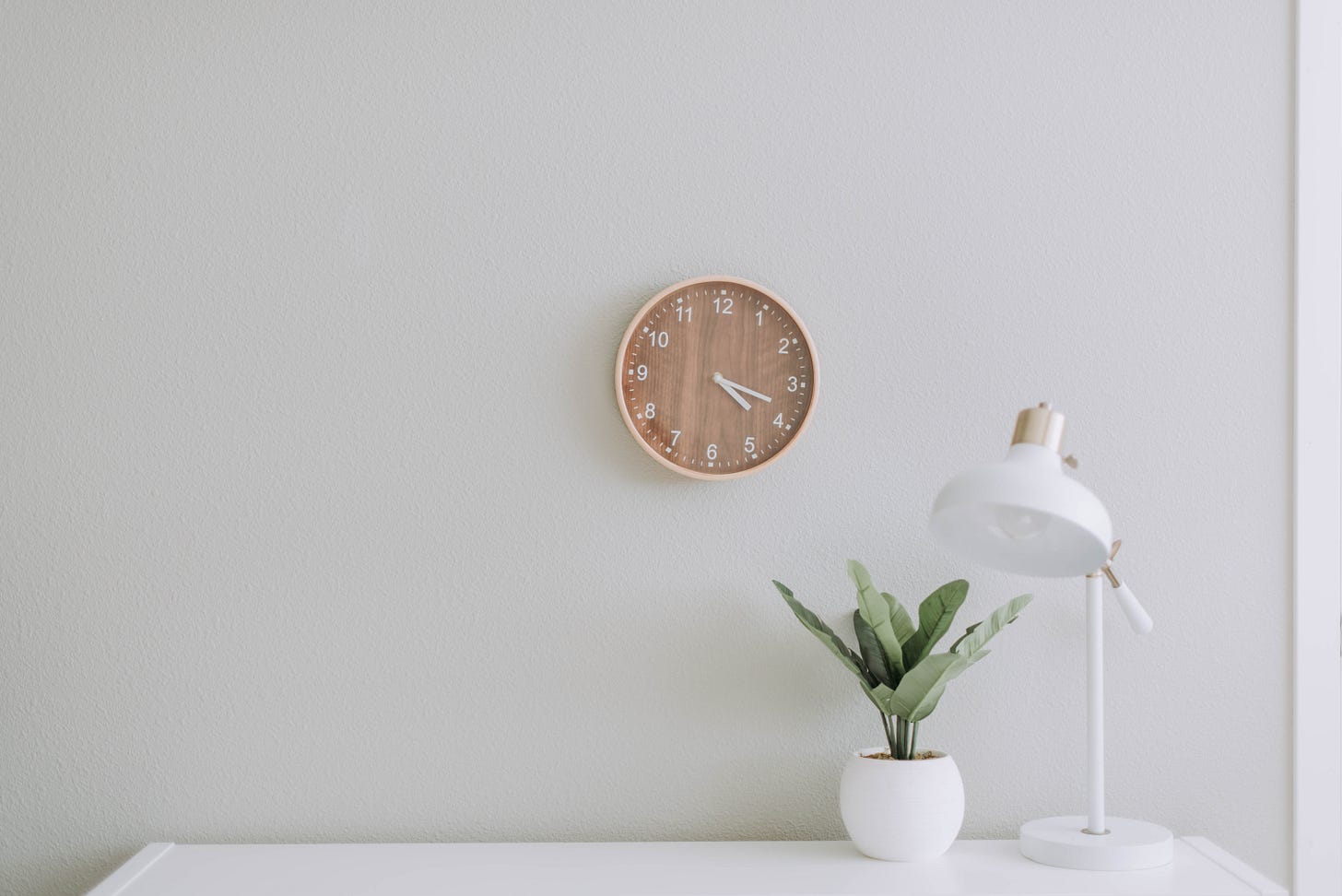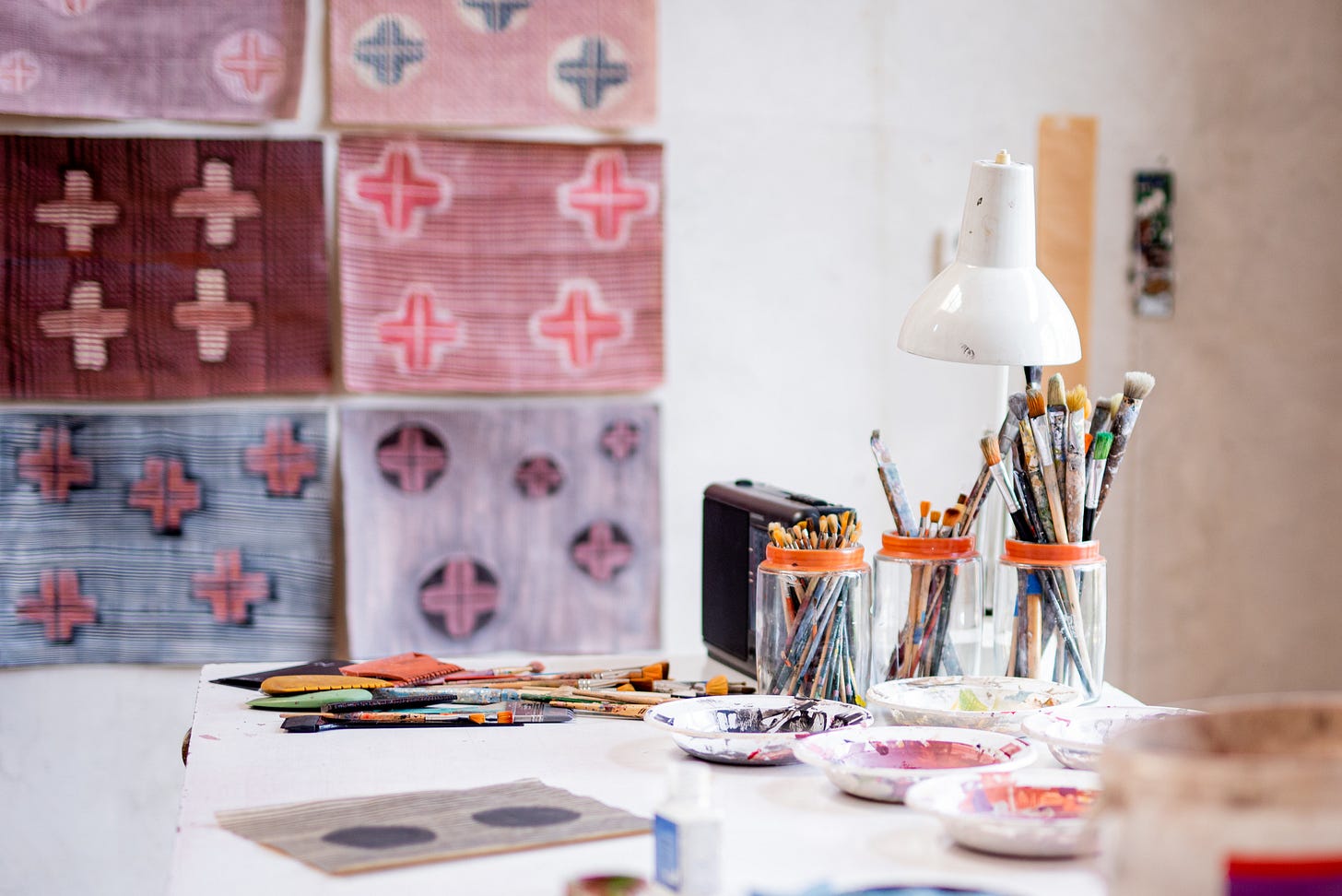Embracing time constraints in your creative practice
Or why parents have the upperhand in shipping creative work
When I turned 30, I quit my job (and ultimately a career) in fashion buying and signed up for a year-long part-time writing program called The Writer’s Studio at Simon Fraser University in Vancouver. I was going to eventually find a part-time job, but for the time being, I was going to focus on writing. It was the start of a new year, and I looked ahead on the calendar to months of writing time, of Saturday classes and evening workshops and daytimes to write.
And I did write.
I sat at my little desk in the morning and at night, and I wrote substantively. I sketched characters, and considered narrative through-lines, and wrote chapters, and drafted outlines and did background research.
Looking back, it was an impactful year and one that did take me from a dabbler with a dream to someone living an artistic life. I read publicly at literary salons and found a community of people who were working seriously on their books.
But the guilt of having all this time to write — to finally have time to write that book and focus on the craft of writing — and not producing a masterpiece outweighed the feeling of productively.
Why wasn’t I further along?
The idea that to be creative you need unlimited resources — time, money, a little cabin in the woods in which they have no outward distractions and someone to do your laundry — and the creative work will manifest itself is not realistic.
For creative parents, it really just is not going to happen. We are juggling multiple priorities and demands — I’m telling my toddler as I write this that it is Daddy’s night to put him down as I have to work just like I read in Julia Cameron’s The Artist Way for Parents — and somewhere at the very end of this long list are your dreams and desires.
Constraints build creativity and time is a natural constraint.
Parents are experts in managing time, 15-minutes provides an opportunity to throw in the laundry, five minutes and it’s time to start the dishwasher, or to quickly research swimming lessons.
What could happen if we fill those moments with creativity too?
Moments of time filled productively with creative work build upon each other.
Just like fragments of fabric stitched together in pattern become a quilt, your creative projects can start to take shape, one small part at a time.
Here are some ways to embrace time constraints in your creative practice:
Creating on-demand and timed prompts
In a short fiction workshop on setting I recently attended at the Anansi bookshop, writer Eve Crocker, gave out four writing exercises and called them demand writing. It was the first time I’ve heard that term, but really its should have been obvious: writing exercises help you write on demand.
I like to use prompts, questions, exercises as a quick entryway into creative work. I don't have to come up with a place to start, I can enter and have a direction that I may not have conceived of my own. I use them intentionally, with a theme or a topic, at times. Or, I use them to quickly come up with something in a short period of time.
For five minutes, or ten, or even twenty, I can write without fear on the topic because time does not allow any self-doubt; it frees me to experiment, write badly or just imperfectly, because I keep writing until the time’s up.
I’ve used time in other creative work as well: a few warm up sketches, a timed pose in life drawing; a creative starter that takes a minute or two. Just set a timer and get started.
One day retreats
I love calling chunks of time to work on a creative project a retreat. Years ago (and long before I had my son), I participated in the three-day novel writing contest on Labour Day weekend. I would grocery shop and buy ready-to-eat foods, snacks, and get together my writing supplies, and hunker down for the three days until the contest was over and write a novel. It didn’t really matter that it was a contest, what I wanted was the uninterrupted time to complete a first draft of something new. Like the timed prompts, a retreat allows you to just sit down and hammer it out.
I don’t have time like that anymore, but sometimes I have a day free (an extra day off work or a holiday) where my son is at daycare and I have a 9-5 chunk of time. I feel cheated when I use these for errands or other necessities (unless I am exhausted and need to sleep). Instead, I will create a day retreat.
For the retreat, I make a plan. I find an inspiring location: the library, a co-working space, a studio space. I plan out my snacks, and find a place to treat myself to lunch, and I pack my supplies. I plan out what I want to tackle in the creative project: a passage, a chapter, a small project. And I use that day off to make progress on my creative goals.
30-day challenges or 100-day projects
NaNoWriMO is a challenge where you write a novel in a month. Articulations, an art store in Toronto, hosts a yearly 30-day FILL-ER UP Sketchbook Challenge. Suleika Jaouad of The Isolation Journals hosts a 100-day project with her community every year. No matter how long you can commit to in a day, longer term challenges can help you build a daily practice.
For some, social media can help inspire their daily challenges by creating a visual accountability measure. For a set period of time, creatives post something of a daily practice: a sketch a day in their Instagram grid, a short film on Youtube shorts, a poem recited on TikTok.
For others, like many people who do NaNoWriMo every year, a community of creatives can keep them accountable, sharing progress, expressing highs and lows of the process, and even building connections.
Whatever your method, a longer term challenge creates structures of time for you to work toward a creative goal — whether that’s to finally finish a first draft of that book you have been mulling over to working on a skill like drawing portraits, or learning a different medium like watercolour painting.
However I embrace time constraints to do creative work, my goal remains the same. I want to create, more than I want to do nothing.
And as a parent, that means embracing those small periods of time; whatever time I can spare.
Even if this isn’t the best newsletter I have ever written.
Even if I keep get interrupted by both my partner and my child multiple times while writing this draft.
Even if I only get it published at the 11th hour before my own set deadline.
It’s better to have created, than to not create at all.
Exercise
Planning Exercise: What allocations of time could you use to work creatively? How can you best use this time for your creative work? What would make it joyful? And what would hold you accountable?
Dog Ears
Julia Cameron, “The Artist Way for Parents”: One of the few sources on the topic of artistic practice for parents, Cameron’s philosophies remain the same as in the Artist Way: write daily morning pages, go on artist dates, and commit to your creative work. However, she also talks about setting boundaries around your creative practice as I illustrated above — an approach I don’t always like to take, but is one option to making time.
Brandon Stosuy, Make Time for Creativity: A Self-Guide (2020).



